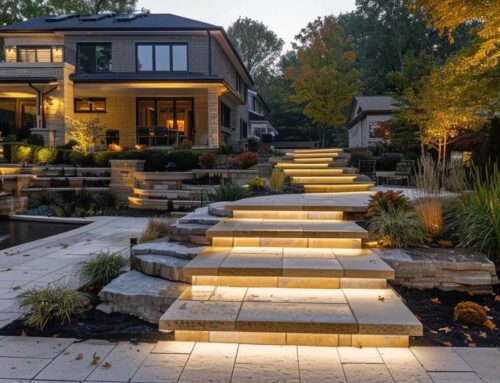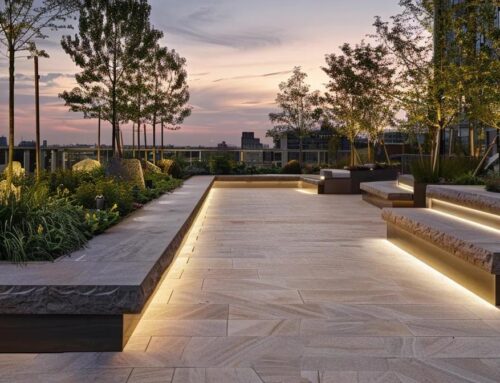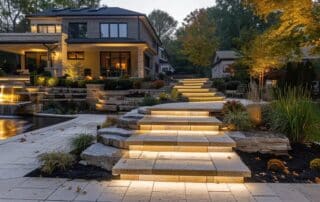Are you looking to transform your garden into an eco-friendly oasis? Eco-friendly hardscaping options not only enhance your outdoor space but also promote sustainability. In this article, I’ll cover the top materials to consider, innovative techniques that reduce your environmental impact, and effective solutions for garden walkways. By exploring these options, you’ll discover how to create a beautiful landscape while minimizing harm to the planet. Let’s tackle the challenges of hardscaping together and pave the way for a greener future in your yard.
Understanding Eco-Friendly Hardscaping Options for Sustainable Gardens

Eco-friendly hardscaping involves using sustainable building materials to create outdoor spaces that minimize pollution and conserve energy. In the following sections, I will explore key principles of sustainable hardscaping, about landscape architecture, highlighting how these choices not only enhance your garden’s appearance but also support soil nutrient health and reduce environmental impact. You’ll gain practical insights into bret-mar landscape landscaping services that prioritize eco-conscious methods and materials.
Defining Eco-Friendly Hardscaping and Its Importance
Eco-friendly hardscaping refers to the use of sustainable materials and practices to create outdoor spaces that promote environmental health. By integrating features like stone walls or permeable pavers, we support beneficial organisms in the soil while managing municipal solid waste effectively. This approach not only enhances the visual appeal of your garden but also contributes to sustainable landscaping practices, ensuring a healthier ecosystem in your own backyard.
Key Principles of Sustainable Hardscaping
In my experience, the key principles of sustainable hardscaping revolve around the thoughtful selection of materials and designs that enhance both environmental health and aesthetic appeal. For instance, utilizing permeable pavers allows rainwater to filter through while reducing runoff, which benefits local wildlife and supports soil health. By integrating features that take advantage of natural elements like wind barriers, we can effectively reduce energy consumption and lower carbon footprints in our landscaping projects.
Now that we grasped the fundamentals of eco-friendly hardscaping, it’s time to look at the materials that can bring these ideas to life. The right choices can transform not just your garden, but your commitment to sustainability.
Top Eco-Friendly Materials for Hardscaping

When considering eco-friendly hardscaping for your wildlife garden, I prioritize several sustainable materials to enhance both beauty and function. Using recycled aggregates for patios and pathways not only reduces waste but also supports biodiversity. I also recommend durable stone and brick choices that blend seamlessly into your landscape construction. Additionally, eco-friendly pavers for driveways and walkways provide durability while minimizing environmental impact, making them excellent options for any outdoor project.
Recycled Aggregates for Patios and Pathways
Recycled aggregates for patios and pathways present a practical and eco-friendly option for enhancing your garden while fostering a healthy ecosystem. By utilizing materials like crushed concrete or repurposed stone, I can help you create durable surfaces that not only support healthy organisms in the soil but also reduce reliance on new resources, including plastic. This approach complements the natural growth of sod and crops, ensuring that your outdoor spaces maintain both aesthetics and environmental responsibility.
Sustainable Stone and Brick Choices
Choosing sustainable stone and brick materials for your hardscaping can significantly benefit your garden’s ecosystem. By opting for products that support groundwater recharge and natural erosion control, I ensure that your outdoor space promotes a healthy habitat for local wildlife, including beneficial deciduous plants. Utilizing options that prioritize reuse, such as salvaged bricks, not only adds charm to your landscape but also emphasizes environmental responsibility in your gardening efforts.
Durable and Eco-Friendly Pavers
Durable and eco-friendly pavers are an excellent choice for enhancing your garden while combatting environmental degradation. During my projects, I often recommend pavers made from recycled materials, which help retain topsoil and promote the health of the ground beneath. For instance, incorporating features like permeable pavers can allow rainwater to filter through while nourishing nearby plants and supporting green roofs, ensuring your outdoor space thrives sustainably.
With the right materials, hardscaping can be both strong and gentle on the earth. Next, we’ll explore innovative techniques that bring sustainability to life in your outdoor spaces.
Innovative Techniques for Sustainable Hardscaping
Implementing permeable surfaces in your landscape designs allows rainwater to seep through, reducing runoff and supporting a healthier ecosystem. I also recommend utilizing native gravel and soil mixes, which promote local plant growth while minimizing transport emissions. Integrating green infrastructure can enhance the functionality of your construction, creating a dynamic environment that thrives naturally. Let’s explore each of these innovative techniques in detail.
Implementing Permeable Surfaces
Implementing permeable surfaces in your garden is a smart choice for improving water quality and fostering healthy horticulture. These surfaces allow rainwater to seep through, reducing runoff and promoting groundwater recharge, which is essential for nurturing evergreen plants. During my landscaping projects, I’ve seen how permeable installations not only support efficient energy use by creating natural cooling effects but also enhance the overall aesthetic of the space, showcasing thoughtful landscape architecture that benefits both the environment and the homeowner.
Utilizing Native Gravel and Soil Mixes
Utilizing native gravel and soil mixes in hardscaping projects greatly enhances the health of your garden ecosystem. These mixes not only support the growth of local plants and flowering meadows but also attract beneficial insects that contribute to pollination and natural pest control. By incorporating natural manure and organic fertilizers into these mixes, I ensure that your garden thrives sustainably, providing a robust foundation for features like pavers while promoting healthy soil nutrient levels.
Integrating Green Infrastructure
Integrating green infrastructure in your landscape not only enhances the visual appeal but also plays a significant role in reducing your ecological footprint. I often use sustainable materials like reclaimed lumber and local sand to create structures that manage stormwater effectively, which is crucial for maintaining soil health. By following guidelines from the United States Department of Agriculture on sustainable practices, I help clients make informed choices that preserve natural resources and promote resilience in their gardens.
As we build solid paths with innovative designs, let’s consider how garden walkways can reflect these ideas. Simple and eco-friendly solutions await those who wish to connect beauty with purpose in their outdoor spaces.
Eco-Friendly Solutions for Garden Walkways
In designing eco-friendly garden walkways, I focus on practical solutions that incorporate natural stone pathways, utilize decking from sustainable sources, and feature recycled materials. Each of these choices not only minimizes waste but also enhances sustainable landscape design. By creating pathways that attract pollinators, we contribute to a healthier ecosystem while effectively diverting materials from the landfill. Let’s delve into each option for a more sustainable approach to your outdoor spaces.
Creating Natural Stone Pathways
Creating natural stone pathways in your garden not only enhances its beauty but also supports soil health. When I design these walkways, I often use locally sourced gravel and stones that blend seamlessly into the landscape, allowing for proper drainage and minimizing pesticide runoff. Incorporating compost into the surrounding areas enriches the soil, fostering healthy turfgrass growth and ensuring your garden thrives sustainably.
Incorporating Wooden Decking From Sustainable Sources
Incorporating wooden decking from sustainable sources into your yard not only enhances the visual appeal of your landscape design but also aligns with eco-friendly practices. I often choose reclaimed wood or bamboo, which can withstand weather elements while contributing to effective rainwater harvesting systems in your garden. This method not only prevents standing water, which can attract pests, but also creates a functional patio space that promotes healthy outdoor living.
Designing Pathways With Recycled Materials
Designing pathways with recycled materials is a practical choice when creating eco-friendly garden spaces. In my projects, I’ve found that using repurposed bricks, concrete, or stones not only helps reduce waste but also contributes to the overall aesthetics of the landscape. These materials can effectively manage dust and prevent erosion while supporting groundwater recharge, especially when integrated with features like rain gardens and strategically placed retaining walls, enhancing both functionality and beauty in your outdoor areas.
Walkways can lead us through nature, but they also raise questions about water. Efficient water management plays a crucial role in sustainable hardscaping, guiding us to better choices for our landscapes.
Managing Water With Sustainable Hardscaping

Installing rain gardens and bioswales in your landscape is essential for managing water effectively. These features not only capture and filter runoff but also support water conservation in your garden. I often recommend using recycled water in hardscaping elements to optimize resource consumption. Lastly, the benefits of permeable paving come into play, allowing rain to penetrate the surface, nurturing soils and benefiting overall garden health.
Installing Rain Gardens and Bioswales
Installing rain gardens and bioswales in your landscape design is a smart move for promoting sustainability while managing water effectively. I often recommend using native plants and perennial species, which thrive in these environments and enhance biodiversity. By incorporating organic fertilizer and mulch, I ensure these systems capture rainwater efficiently, filter pollutants, and provide nourishment for the plants, supporting a healthier ecosystem in your garden.
Using Recycled Water in Hardscaping Features
Using recycled water in hardscaping features has proven to be an effective strategy for enhancing soil fertility, especially during times of drought. By integrating recycled water into your sustainable landscapes, I help promote healthy plant growth and reduce time and resources spent on irrigation. Additionally, I recommend using woodchips as a top layer in your garden beds; they not only enhance aesthetics but also improve carbon sequestration in the soil, further supporting a flourishing ecosystem.
Benefits of Permeable Paving
Using permeable paving in your garden design offers significant benefits for energy conservation and irrigation efficiency. These surfaces allow rainwater to filter through, replenishing groundwater and supporting beneficial groundcover species. By incorporating techniques such as drip irrigation, I can optimize water use further, ensuring your plants receive the moisture they need while minimizing waste and promoting a sustainable landscape.
Sustainable hardscaping isn’t just theory; it breathes life into everyday gardens. Let’s look at real examples that show how these principles transform outdoor spaces into functional works of art.
Case Studies of Sustainable Hardscaping in Gardens
Successful eco-friendly garden transformations often showcase innovative techniques that enhance local ecosystems while addressing climate challenges. Community projects featuring sustainable hardscaping highlight the importance of permeability in managing water runoff and reducing water pollution. Lastly, I will share lessons learned from award-winning eco-gardens that effectively minimize herbicide use, creating thriving spaces that benefit both people and nature.
Successful Eco-Friendly Garden Transformations
In my experience, successful eco-friendly garden transformations often involve creating infrastructure that supports both beauty and sustainability. For instance, I worked on a residential project where we integrated organic matter into the soil, enhancing its nutrient profile while fostering biodiversity. By applying techniques such as integrated pest management, we were able to maintain a healthy ecosystem, ensuring that the garden remains environmentally friendly while thriving under the right conditions.
Community Projects Featuring Sustainable Hardscaping
In many community projects featuring sustainable hardscaping, I’ve witnessed the transformative effects of thoughtful garden design. For example, implementing rain barrels alongside native plant installations not only helps manage drainage effectively but also reduces toxicity associated with chemical watering methods. By employing techniques that address erosion and maintain soil integrity, these projects provide practical solutions that enhance both the environment and the local community’s enjoyment of their outdoor spaces.
Lessons Learned From Award-Winning Eco-Gardens
From my experience working on award-winning eco-gardens, I’ve learned that incorporating permeable paving can significantly reduce soil erosion while promoting groundwater recharge. By including native species in these designs, I enhance biodiversity and create habitats that support local wildlife. Additionally, elements such as thoughtfully placed fences can help delineate spaces while maintaining the natural flow of the landscape, aligning with sustainable practices and ensuring that each project contributes positively to the environment.
Conclusion
Embracing eco-friendly hardscaping options for your garden significantly enhances both its beauty and ecological health. By selecting sustainable materials and innovative designs, you can support local wildlife and reduce environmental impact. Implementing practices like permeable surfaces, native plant installations, and recycled materials fosters vibrant outdoor spaces while conserving essential resources. Prioritizing these eco-conscious choices ensures your garden thrives sustainably and contributes positively to the environment for years to come.




